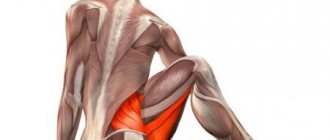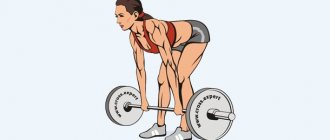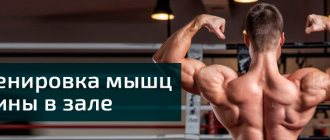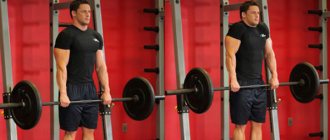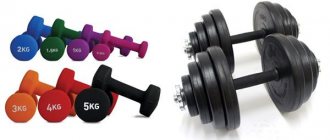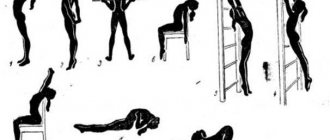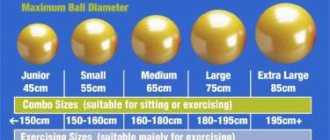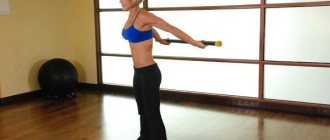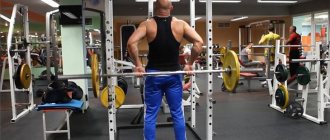To perform dumbbell exercises correctly and with maximum efficiency, women need to consider the following::
- Rely on your own strengths and do not overwork. It is recommended to start with two workouts per week, no more than 40 minutes each.
- The number of repetitions varies from 10 to 20 times depending on the level of training. There can be 2 approaches, after 1 month 2 more times are added.
- Watch your breathing. There is no need to detain him. At the moment of greatest tension, you need to exhale.
- For the greatest control over execution, exercises are best done in front of a mirror.
- After each approach, it is recommended to take a break of 30-60 seconds.
- The training begins with a basic set of exercises to warm up the muscles (lunges, squats and deadlifts).
Exercises for the latissimus dorsi muscles
Let us go over the basic and most powerful exercises for our latissimus dorsi muscles.
The first exercise will rightfully be pull-ups.
Pull-ups
This is the coolest exercise for developing the latissimus dorsi muscles, which many people don’t do for various reasons, but in vain.
This is an extremely physiological exercise for you and me, because... our ancestors were forced to spend a lot of time in the trees. However, if you believe that man appeared on Earth as a result of other circumstances, then I cannot convince you of this.
But I think it’s pointless to argue that the crossbar appeared on Earth much earlier than deadlifts and dumbbells, this is already clear)
Pull-ups develop the width of the “wings”, and horizontal rows (any) develop thickness (the edge of the lats thickens).
Learn to turn off the biceps from work when doing pull-ups (due to the “muscle feeling”) so that the biceps does not steal the load from the latissimus muscles. At each point in the pull-up movement, think about your lats and how they contract at each point in the movement.
If you have no problems with this, and you definitely “bomb” your lats in pull-ups, then it’s time to decide on the following points:
Grip:
- Narrow;
- Average;
- Wide;
Brush position:
- Directly;
- Toward yourself (reverse grip);
- Parallel;
Load:
- Your weight;
- With weights;
- Standing on a support (in the simulator or from the hands of a partner);
The choice, as we see, is very healthy. So, in general terms:
The wider the grip = more lat work + less work.
The narrower the grip = more biceps work (less back) + more work.
Wide or narrow grip?
The narrower the grip, the greater the amplitude of movement created, but the biceps will work harder. If you have learned to feel your lats well and turn off your biceps, then you can do pull-ups with a narrow grip, because the work in this case will be stronger (greater amplitude of movement). But if you feel that your arms are getting clogged during pull-ups, then take them wider. Also, try using an "open grip" (this is when your thumb is not wrapped around the bar), this will reduce the stress on your forearms.
In general, try to do pull-ups with a “medium grip”, because... In this case, it will be easier to feel the lats and turn off the biceps.
What is the position of the hands?
The more the hand is turned (supinated towards itself, as with a reverse grip), the less the load on the forearms, but we won’t be able to take a wide reverse grip because of our anatomy, and the narrower we take it, the more the biceps works. The solution is a parallel grip (on a horizontal ladder, for example). This way the hand will be supinated and you can take it wider.
Pull up to your chest or behind your head?
If you pull yourself up by your head, you use fewer back muscles than when you pull yourself up to your chest. But the advantage of doing pull-ups is that this way you engage more of the upper back muscles. In short, pull-ups to the chest involve more muscles in the work (more basic exercise), and behind the head emphasizes the upper back muscles (more isolating). At the initial stage, I would not bother with this issue and would pull myself up to my chest.
Should I add weights or not?
In order for muscles to grow, a progression of loads is needed. If the load does not increase, then there is no point in the muscles increasing, because... this is a very energy-intensive process. There are a couple of clarifications. First, you should add weights when your technique is perfect (you feel the lats perfectly). And secondly, you should work in the range of 6-12 repetitions (approximately), so when you can already do pull-ups with perfect form more than 12-15 times, then it’s worth increasing the weight.
Exercise vertical block row
These are, one might say, “lightweight pull-ups.” Everything I said about grips, hand position, load, etc. all this applies to this exercise. For beginners, this exercise is BETTER than pull-ups, because, as a rule, they cannot yet do pull-ups properly. Moreover, with this exercise it is easier to control the load and contraction of the lats. If you are an advanced lifter, you should definitely include this exercise in your arsenal AFTER your pull-ups to further fatigue your lats.
Bent-over barbell row
This exercise belongs to the “horizontal rows”, i.e. builds the latissimus dorsi muscles in thickness. The main thing in absolutely all deadlifts is a straight back! This will save you from injury, and will also allow you to work your latissimus muscles more specifically.
Almost everything that I said in pull-ups about the grip is also true for bent-over barbell rows, but there is one BUT.
If you take a reverse grip on the barbell and perform rows, you will notice that your elbows do not spread out to the sides, but move in parallel, accordingly, the latissimus muscles can be felt better, but the biceps also work stronger. When we grab with a direct grip, the elbows spread out more (especially with a narrow grip), so the trapezius and rear delta are more involved in the work. So it goes.
Now about the tilt:
- More tilt = more back work;
- Less tilt = more trapezius work;
In my opinion, and in my experience, it is best to grab with a Medium overhand grip and approximately 20-30 degrees from horizontal (i.e. almost parallel to the floor). The back must be straight, and the bar moves parallel to the bent hips.
T-bar row
Almost the same as bent over rows. But here a deeper study of the inner part of the back (between the shoulder blades) is given. In fact, this is simply a more convenient version of the bent-over barbell row.
There are a lot of different T-bar pulls. The main ones are in a standing and lying position. When you perform the exercise while standing, it is practically the same as the bent-over row of a barbell, it’s just more convenient, but lying down, a number of inconveniences already begin here, because To properly contract the lats, you need to bend in the back (in the scapular region), and this is difficult to do while lying down.
In general, if you have a standing T-bar, then you can choose it as an alternative to bent-over barbell rows, but if you have a bench press, then it’s better not to do it, especially at the initial stage.
Bent-over dumbbell row (with arm support)
The technique for performing the exercise should be as follows:
- Lean forward and take the dumbbell in your right hand, lean on the bench with your left hand and left leg bent at the knee, and put your right leg back.
- The movement of the hand should be strictly vertical, and the movement should be parallel to the body (the hand does not move to the side).
- The body does not change position! The back is always straight (bent in the opposite direction!).
There is a wider range of motion here than with the bent-over barbell row, because... the bar does not interfere with raising the elbow above the lower back. More work and muscle contraction. Support with your knee and hand allows you to unload the spine. And also, because The exercise is performed with one hand, then you can feel your muscles better.
Lever pull in Hummer
Hammer-type exercise machines appeared not so long ago, but have successfully entered all modern fitness centers. This is a great exercise and variation of the horizontal row. The exercise is similar to a one-arm dumbbell row, but because your torso is vertical, it is easier to perform and the weight can be lifted heavier.
Exercise horizontal block row
It is believed that this exercise specifically affects the lower latissimus muscles, but this is very conditional, because The emphasis of the load will depend on where you pull the handle.
- Pull towards the navel = works the bottom of the lats;
- Pull towards the chest = works the top of the lats;
But it will be easiest to pull towards the navel, hence this statement.
A few more tips on the technique of performing this exercise. I very often see how exactly this exercise is performed and I don’t even understand how!
My version of this is: Sit with your back straight (slightly arched back at the shoulder blades), lean forward to stretch your lats. Now pull the handle towards you while simultaneously returning your body to a vertical position.
Very important!!! You should pull with your lats, not with your body! Those. There is no need to pull the handle towards you with your whole body, and then, by inertia, bring it towards you with your hands. The movement begins by pulling the shoulders back, then pulling the handle toward you, feeling the lats at each point, and returning the body to a vertical position.
Exercises on the horizontal bar
- Pull-ups.
Effectively develops the back muscles. There are techniques that take some of the load off the biceps:
- Hold the horizontal bar with all your fingers on one side;
- Perform pull-ups slowly or at a medium pace. In this case, jerking will not help pump up the back;
- Using a narrow grip, you will pump up the trapezius muscles more, and a wide one will pump up the “wings”.
- Exit by force.
You should include this exercise in your home fitness workout after reaching an average level of fitness. It is very beneficial for the entire back. To perform it, you need to hang on the horizontal bar with a medium grip, grasping it from above. Pull yourself up a little and lightly swing your legs forward. This will create momentum, which will help propel your body upward. This is the way out by force. As your training increases, you will be able to do the same without using your legs, but only using the muscles of your arms and back.
The end of a fitness workout should be the same as its beginning - easy, relaxed. The fitball will help you relax your back muscles well. You need to lie down on it and roll back and forth. If there is no such ball, do some bending, just hang on the bar.
Exercises for the trapezius muscle of the back
I have already discussed this issue in great detail in an article on how to pump up a trapezoid. But repetition, as they say, is the mother of learning.
Shrug exercise with barbell
The moment of “SHRUGGING” THE SHOULDERS is important, so it doesn’t matter whether it’s a barbell, a Smith machine or a canister of water, the main thing is to perform this movement.
Shrugs from English. shrug - “shaking.” This exercise really looks like a shrug. We must move the shoulder blades vertically upward. This is the main function of the trapezius muscle.
So, the more you lean forward, the more load will go from above to its middle parts (between the shoulder blades). Beginners do not need this exercise at all, because... So far, at the beginning, there is no point in worrying about relatively small muscles.
It's better to focus on your lats, chest, for example, and legs. The most important thing when performing shrugs is that you should not rotate your shoulders!!! The movement must be strictly up and down.
Our shoulders are poorly adapted to rotational movements, so we can get injured very easily. And in general there is no point in rotation, because... This does not in any way speed up the growth of the trapezius. Hold the dumbbells in your hands or a barbell in front of you and perform the movements as if you were shrugging your shoulders, moving them straight up and down, so you can feel your trapezius contracting.
Competent exercise technique
The back belongs to the “pulling” muscle groups, so when working on it, muscle groups such as the biceps, middle and rear deltoids, and even the hamstrings can “steal” part of the load, so you need to learn to FEEL YOUR MUSCLES. I have already said this many times in many articles.
Moreover, in the end, the maximum load-carrying capacity of machines is easily reached, and by sticking only to them, we are limiting our evolution. Training with free weights inevitably requires more energy than using weight machines. Although effective weight machines do not allow you to train multiple muscle groups at the same time with free weights. Train more muscle groups = more effort = more calories burned, which of course leads to better results.
Versatility in muscle strengthening
While weight machines can help increase overall strength, using a variety of free weights can target several specific muscles at once. The versatility of free weights allows you to tailor your workout to any body part you want, rather than targeting a body part using an isolated movement in a machine, making it difficult to focus the movement at any point we want to engage more.
I looked at this in great detail. Don't be lazy and study this issue.
Back Extensor Exercises
The back extensors are extremely important muscles that not only affect the health of your spine, but also allow you to progress much faster because... stabilize the spinal column and allow the load to progress more efficiently.
Those people who regularly train their spinal extensors have healthier posture and a stronger back.
Deadlift
An exercise that is highly overrated for growing back muscles. It has a concentrated effect on the back extensors, which are not so large compared to the lats and trapezius.
It works on so many muscles, quads, glutes, back extensors, etc. But for back growth in general, this exercise is at the bottom of my list. I believe it should be done at the end of a workout.
The back is always straight. The bar should move strictly along the legs. Grip straight, shoulder-width apart or slightly wider than shoulder-width apart. Be sure to use a weightlifting belt and deadlifts so as not to develop a hernia. Look in front of you, butt down, knees bent. At the same time we straighten our legs, back and lift the barbell along our legs.
Exercise hyperextension
This exercise works the spinal extensors quite well, but I put it at the very end because... You shouldn’t overdo it with it, you can seriously injure your lower back by simply pulling your body up a little at the bottom point, so you need to progress the weights very carefully.
There are many variations of this exercise, but I will tell you about the one that I think is the best, when you lie face down with your legs secured to the bolsters.
The back is straight, you lower yourself down and, feeling the tension in the lumbar region, rise up, contracting the extensors of the spine.
This exercise is best performed as an additional exercise for abdominal training, because... the spinal extensors are antagonists of the abdominal muscles, which means the abs will receive better recovery.
OK. As you can see, there are plenty of exercises. But how to pump up your back muscles if we are talking about a specific workout?
Other effective dumbbell exercises for women
In addition to the described complexes, there are also a lot of useful exercises for training different muscle groups.
Dumbbell Curls and Overhead Press
This exercise works the shoulders and biceps. The legs are placed at the level of the pelvis. The dumbbells are held so that the palms are turned away from you. At the first stage, the arms are bent at the elbows and the projectiles are raised to the chest, then they are pulled up above the head.
In the second stage, the dumbbells return to chest level and lower down to their original position.
Exercises with dumbbells on one leg “Scarecrow”
This exercise works the back and shoulder girdle, and using only one leg as support helps develop balance.
Execution steps:
- Starting position - standing on one leg, bend the other at the knee, pulling the thigh closer to the stomach.
- The arms are bent at the elbow joints and placed parallel to the floor, the forearms are facing upward, and projectiles are clutched in the palms.
- As you exhale, lower your forearms down.
- Several repetitions are performed with alternating legs.
Exercises with dumbbells “French press”
You need to lie down on a bench or mat. Dumbbells are taken in two hands and raised up perpendicular to the floor. Next, the arms are bent only at the elbows, heading towards the head.
Then they return to the starting position.
Exercises with dumbbells “Boxer”
The emphasis is on the back muscles and triceps. The legs are slightly bent, the body is tilted forward, the back is straight. The arms are spread one forward, the other back. The front arm is a continuation of the body (extended in line with the spine).
Then the hands change places. Several repetitions are performed.
How to pump up your back. Back training program
As you understand, a training program is a very individual thing, especially when we talk about how to pump up your back, because... this is a very large muscle group. More than half of the questions that I receive by email and in comments are questions related to the training program.
I discussed the issue of choosing a training program in great detail in this article.
I want you to understand that almost any program will work at a certain time and on a certain person. I can only give a training program that will suit the majority.
Rules for creating a training program for the back:
- Mainly basic exercises.
- Upper + lower rows (to develop muscles in width and thickness).
- Heavy weights (6-12 reps + progressive load).
So, the very first complex for a beginner will look like this (complex No. 1):
- Vertical block thrust: 1-2 sizes. sets + 3-4 sets x 6-12 reps.
- Bent-over barbell row: 1-2 sizes. sets + 3-4 sets x 6-12 reps.
All? Yes all. These two exercises will be enough to avoid overtraining and cause a great response in your lats. You can do these exercises for six months or a year and not worry. There will be wonderful growth.
The following option is for a beginner (complex No. 2):
- Pull-ups (or pull-down rows): 4 sets x 6-12 reps.
- Bent-over barbell row: 1-2 sizes. sets + 4 sets x 6-12 reps.
- Deadlift: 2 sizes. sets + 3 sets x 6-12 reps.
Deadlifting will stimulate the growth of your back extensors, as well as the growth of your body as a whole, because... it increases blood circulation in the lower body, which promotes increased testosterone production. The trapezoid is also strongly involved in the work, which will also contribute to its excellent growth.
So, next it’s worth adding one more important exercise for an athlete with an average level of training (complex No. 3):
- Pull-ups: 1-2 sizes. sets + 4 sets x 6-12 reps.
- Bent-over barbell row: 1-2 sizes. sets + 4 sets x 6-12 reps.
- Bent-over dumbbell rows: 4 sets x 6-12 reps.
- Deadlift: 2 sizes. sets + 3 sets x 6-12 reps.
Another option for the intermediate level:
- Pull-ups: 1-2 sizes. sets + 4 sets x 6-12 reps.
- Bent-over barbell row: 1-2 sizes. sets + 4 sets x 6-12 reps.
- Hammer Rows: 4 sets x 6-12 reps.
- Deadlift: 2 sizes. sets + 3 sets x 6-12 reps.
Well, the third option for the intermediate level:
- Pull-ups: 1-2 sizes. sets + 4 sets x 6-12 reps.
- T-bar pull: 1-2 sizes. sets + 4 sets x 6-12 reps.
- Horizontal block row: 4 sets x 6-12 reps.
- Hyperextension: 4 sets x 10-15 reps.
So, I want to note a very important point! You shouldn’t switch to using 3 or 4 exercises if you are progressing well with just two exercises! There is no need to change what works great.
Now a few advanced complexes for people using a very deep split (splitting the body for 4 or 5 training days), complex No. 4:
- Pull-ups: 1-2 sizes. sets + 4 sets x 6-12 reps.
- Vertical block thrust: 1-2 sizes. sets + 4 sets x 6-12 reps.
- Bent-over barbell row: 1-2 sizes. sets + 4 sets x 6-12 reps.
- Bent-over dumbbell rows: 4 sets x 6-12 reps.
- Shrugs with barbell/dumbbells: 2 sizes. sets + 4 sets x 6-12 reps.
Another option for the advanced athlete:
- Pull-ups: 1-2 sizes. sets + 4 sets x 6-12 reps.
- Vertical block thrust: 1-2 sizes. sets + 4 sets x 6-12 reps.
- Bent-over barbell row: 1-2 sizes. sets + 4 sets x 6-12 reps.
- Hammer Rows: 4 sets x 6-12 reps.
- Shrugs with barbell/dumbbells: 2 sizes. sets + 4 sets x 6-12 reps.
Or the third, also a cool option for an advanced athlete:
- Pull-ups: 1-2 sizes. sets + 4 sets x 6-12 reps.
- Vertical block thrust: 1-2 sizes. sets + 4 sets x 6-12 reps.
- Bent-over dumbbell row: 1-2 sizes. sets + 4 sets x 6-12 reps.
- Horizontal block row: 4 sets x 6-12 reps.
- Shrugs with barbell/dumbbells: 2 sizes. sets + 4 sets x 6-12 reps.
- Hyperextension: 4 sets x 10-15 reps.
There are a huge number of advanced complexes, but I brought those closer to ordinary people, i.e. for those who are already quite well trained, but do not use steroids (with steroids, the volume of the training load can be safely multiplied by two).
Many professional athletes divide their backs into two training days. On the first day they do vertical rows, pull-ups, etc., i.e. exercises that increase the width of the back, and on the second day, various horizontal rows that increase the width of the back muscles, but, as you understand, the average person does not need this.
A little about home workouts
It is recommended to train the back muscles, and indeed any muscles of the human body, under the guidance of a trainer in the gym. However, many are unwilling or unable to spend money on such services and prefer to study at home. Opinions vary regarding the effectiveness of home workouts, but in fact, it is quite possible to pump up your back without going to the gym. The main thing is to aim for the desired result, not to give up, to exercise systematically, striving for results, and to perform the exercises correctly.
Advice! It is recommended that you seek help in creating a training program from an experienced specialist in this field. The trainer will also be able to show you how to do the exercises correctly. This will not be amiss for beginners, even if they plan to practice at home.
The key to quickly increasing muscle size is the use of additional load. In the gym, progress will be seen faster, not only because an experienced athlete will lead the training, but also because there is a lot of different equipment, the weight of which can be gradually increased. At home, a person is very limited in this regard - as a rule, at home there are only small dumbbells or a light barbell.
Attention! Heavy weights can be used no earlier than after 2 years of regular training, provided that the weight is gradually increased.
The main principles of home training are as follows:
- regularity of classes . Training should be carried out according to the program at least 2 times a week. More frequent exercises will not allow the muscles to recover, and infrequent exercises simply will not give results;
- systematicity . It is important to perform all exercises in sets of 10-15 repetitions. The load can be increased if there is a feeling that it is no longer enough;
- warm- up This is an important part of any workout. Without it, it will not be possible to prepare your muscles for exercise and can harm your health. It is with a warm-up that you need to start every workout;
- variety . It is better to use different exercises - this will make it possible to load all the muscles gradually.
Important! Before starting a training program, it is important to determine the desired results and understand which muscles need to be worked. Different exercises target different muscle groups.
How to pump up your back by combining training with other muscles
How to pump up your back and combine back training with other muscle groups is a very important question, because... directly affects your progress.
Many people train 2-3 times a week, which simply does not allow for a separate day for their back. Although the back deserves a separate day for training, because... this is the largest muscle group in the upper body, and the second largest in our body (after the legs).
That is why I decided to consider this issue in detail.
So, how to combine back training with other muscles?
I would combine it this way:
- back + deltoids (do not interfere with each other, because the shoulders push and the back pulls);
- back + chest (antagonists, work great in combination, Arnold method);
- back + biceps (classic push-pull split, both pulling groups);
- back + rear delts (professional method, then chest + front delts are trained);
Back + arms - this is not very good, because... Most likely you are undertraining one of these muscle groups, I would better connect the back with the shoulders (deltas). In general, try to set aside a separate day for your back if your fitness levels are already high enough.
Features of organizing training
Dumbbell flyes require good hand coordination
To build muscle mass, several conditions must be met:
- Sufficient tension – for the muscle this means working with weight (70–90% of the maximum) or working in a stretched state. In training with apparatus, the first option is implemented. The weight is selected so that the athlete, following the technique, can make from 5 to 10 movements in 1 approach. The number of approaches depends on the degree of development, preferably at least 4–5.
- Sufficient effort - strong muscle tension appears under the influence of a powerful nerve impulse. The latter is formed in the brain against the background of intense work of the central nervous system. Exercising with heavy weights places maximum stress on the central nervous system. Light weight does not stimulate the central nervous system; therefore, the athlete does not achieve the desired effect.
- Frequency – muscle recovery requires an average of 48 hours. In fact, it is necessary to take into account the characteristics of the central nervous system. If after 2 days the muscles are able to perform the same load, the central nervous system cannot do this. It is not recommended to work on your back more than once a week.
- Inclusion of the maximum number of muscle fibers - including additional non-target ones. Therefore, for hypertrophy, the best option is complex multi-joint exercises, rather than isolated ones. But it must be taken into account that the greatest load in the deadlift falls on the muscles of the thighs and buttocks.
- Sufficient rest does not depend on the type of equipment used, but determines the final result of the exercise. The heavier the weight, the longer the rest between approaches should be - up to 5 minutes, or even more. If the level of ATP in the muscles is not restored, the exerciser will not be able to work at full strength in the next approach.
- Absence of pain – this means acute pain. Aching or pulling occurs due to tension. Moreover, the first “victims” are the weakest muscles, which provide constant discomfort in diseases of the spine. This kind of pain is worth enduring. The sharp and tingling sensation cannot be ignored.
In a healthy person, pain in the back after exercise occurs only in one case: if the technique is not followed.
Questions related to how to pump up your back
At this point, the topic of back training is almost covered, but I feel that some questions may still arise. I decided to collect all the questions that I was once asked about back training and highlight them below:
“If after I trained my back over the next few days it doesn’t hurt, does it mean that I didn’t receive the necessary microtraumas for growth?”
Indeed, pain in the next days in a previously trained muscle group indicates microtraumas that will lead to growth, but this is not a necessary sign of growth! The better trained you are, the less pain you will feel. The sign of growth is an increase in load! If the load is constantly growing, then you are growing.
“Should I stretch my back extra between sets?”
Yes. This works great because... In this way, the muscular fascia of the back muscles is additionally stretched, there is better blood supply, and, accordingly, better growth.
“Which exercise for developing the back do you consider the best, if you can only do one exercise on the back?”
Of course, pull-ups. They perfectly grow the latissimus muscles in width.
“Which exercise is better to choose to increase the thickness of the lats: bent-over barbell row or bent-over dumbbell row?”
It’s better, in my opinion, to do bent-over barbell rows, because... It’s easier to progress the load there.
“If you have to combine your back with another muscle group, which one?”
With deltas. Or with biceps (not with arms). This is perhaps the most popular combination.
“What should I do if my wrists hurt a lot while doing pull-ups and vertical block rows?”
Experiment with grips, reverse or straight. Also, a parallel grip easily solves this problem. Well, the traction (straps) should help a lot.
“Do I need to use a belt for bent-over barbell and dumbbell rows?”
I use the belt in almost all exercises where I feel tension in the abdominal cavity (except for abdominal training, of course). This allows you to avoid intervertebral hernia and an increase in waistline. Why do you need a big belly?
Indications and contraindications
It is necessary to pump up the back muscles gradually and carefully so as not to disturb the osteochondral tissue of the spine
Back exercises with barbells and dumbbells are the best way to build muscle mass. The advantages are obvious:
- When working with free weights, the maximum number of target muscles is activated: the latissimus, which gives contour to the back, the teres major, trapezius, and rear delta. The synchronized work of all muscles forms a single harmonious appearance and ensures high functionality.
- By changing the grip, angle, distance, you can focus the work on different muscles. The same exercise with different techniques allows you to create the desired relief.
- Balance is essential when lifting free weights. It is provided by additional stabilizing muscles - a larger number of muscle fibers are recruited into exercises with a barbell.
- The need to control more muscles and the synchronization of their work forces the central nervous system to work more intensely. This is one of the most important conditions for hypertrophy.
- You can exercise with a barbell and dumbbells at home.
- The exercises are universal and equally suitable for girls and boys.
The indication for using free weights is the desire to build decent muscles, become stronger or more functional. By using a barbell wisely, you can cope with numerous diseases and disorders of the musculoskeletal system.
A special training program is recommended for people with spinal problems.
To choose the right exercises and get rid of back diseases, you should take into account and evaluate contraindications. The most common things that are prohibited from going to the gym are:
- Patients with central nervous system disorders, organic and functional. When exercising, the central nervous system is subjected to heavy stress. In this case, it is better to limit yourself to your own weight or light dumbbells and give preference to volumetric training with exercise machines.
- For various diseases of the spine - from “conditional” pinching to hernia. These recommendations are not always justified. If the cause of pain is muscles and ligaments, and not already destroyed vertebrae, you need to deal with it. Only pumping up the back and restoring the normal tone of the affected muscles will help get rid of the disease. However, such athletes need to be careful and strictly follow the technique.
- Weak people should start training with the lightest dumbbells.
- Exacerbation of a chronic disease or acute course of any of them imposes a temporary ban on weight training.
When working with free weights, you must strictly follow the technique. This is the key to hypertrophy of the back muscles and the absence of injuries. Before training in your home gym, you should take a few lessons from a professional trainer. Videos do not replace training.
Using dumbbells
The use of weighting objects will help improve results and speed up their appearance. These are barbells, weights, dumbbells, etc. You can exercise without using additional equipment, but then you will have to wait longer for the effect. Most often, a person chooses dumbbells for home workouts because of their low cost, moderate weight and ease of use. But not everyone understands what equipment is worth buying at the very beginning of training.
On a note! The main advantage of dumbbells when training at home is the ability to work absolutely any muscle.
Dumbbells can be divided into two types - collapsible and non-collapsible (cast) . The former allow you to increase or decrease their weight if necessary. The latter will not be able to change the weight, and over time you will have to buy heavier ones instead. Thus, the collapsible option will be cheaper. And it’s better to buy those that have a threaded version for attaching “pancakes” - they are safer and more reliable.
As for cast dumbbells, for full-fledged training with increasing loads you will have to buy at least 4 pairs of different weights. But using such simulators is much more convenient than collapsible ones.
It is also important to remember the weight of the dumbbells. There is no need to immediately purchase the heaviest ones. For women, the best option, depending on the level of physical fitness, is dumbbells weighing from 2 to 10 kg. The lightest ones (1 kg) are not worth taking - it’s easier to use water bottles instead. And they are of no use in training, even for beginners. For men, the optimal weight of dumbbells can start from 5 kg (minimum). The maximum weight for a beginner is about 15 kg. This is for starters, and then you can buy dumbbells weighing up to 25 kg.
